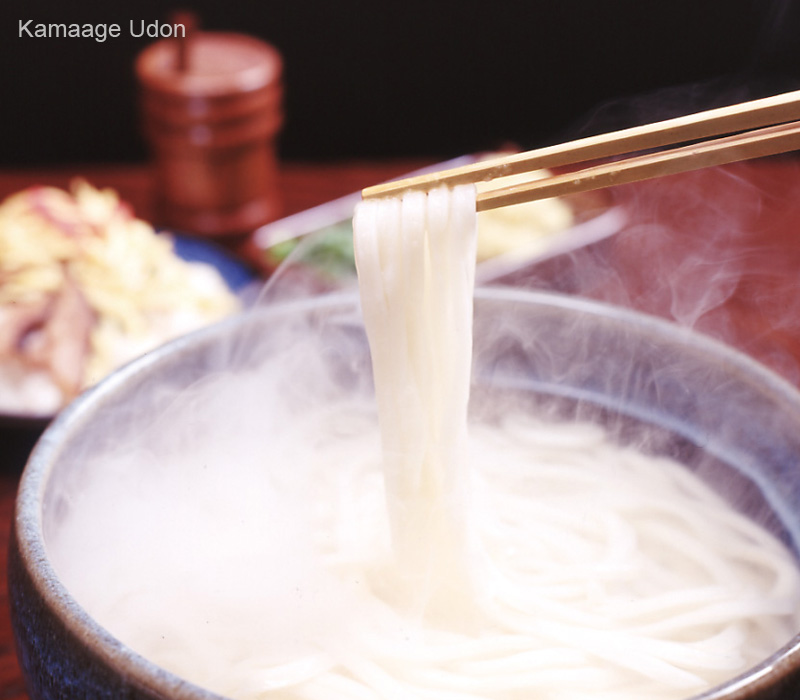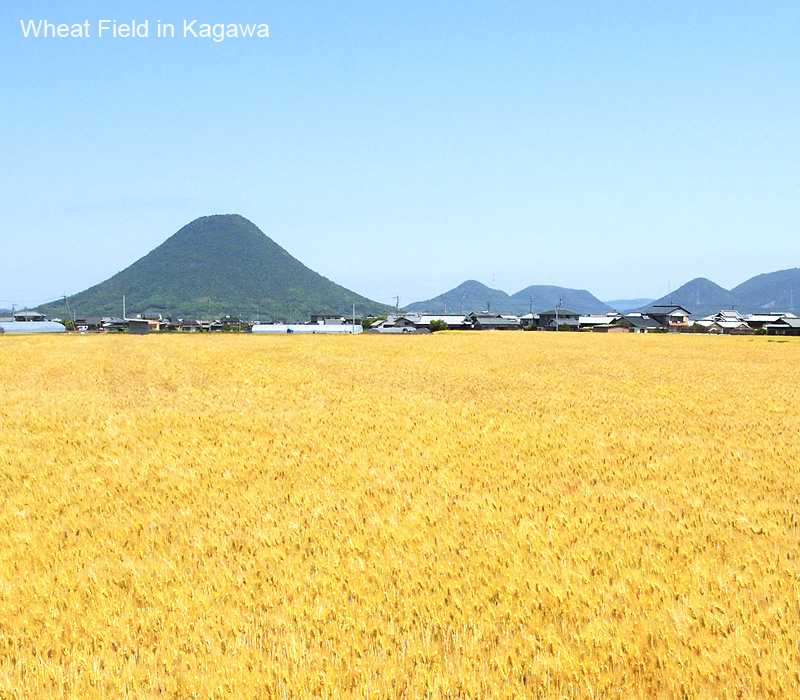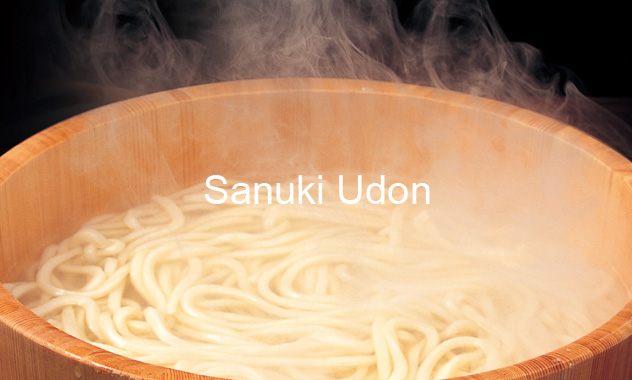Sanuki is the old name of the Kagawa prefecture, which is the smallest among Japan's 47 prefectures. Udon is a traditional Japanese noodle made of wheat flour, salt, and water. Udon is a simple food, but maybe that's why people never get bored of eating them. Udon is extremely popular here in Japan, and there are many different types of Udon all over Japan. Our Sanuki Udon is generally accepted to be the most popular Udon among them all.

- A Brief History of Sanuki Udon
- Today, almost every Japanese knows that Sanuki, or Kagawa prefecture is well known for its Udon noodles. The reason why Sanuki became so well known for its Udon noodles was that Sanuki possessed everything necessary to produce the finest Udon. Sanuki's mild climate and low rainfall were ideal to produce fine quality wheat needed for Udon. Ever since Sanuki was early on described in the "Wakan-Sansai-Zue", or "Illustrated Sino-Japanese Encyclopedia", published in 1712 (the middle Edo period), we know that Sanuki has been providing fine quality wheat at least since then.
Mild climate and low rainfall also provided the ideal environment for producing salt by solar evaporation. Moreover, there was a nice fishing ground of small sardines, which were necessary to make the nice broth of Udon soup. Thus, nature provided Sanuki all the essentials for the finest Udon, and that is why we have such nice Udon characterized by its firm chewy texture and fine wheat fragrance.

- Our Local Wheat, Sanuki No Yume
- The flour made from the local Sanuki wheat, of course, had been used for Sanuki Udon for years, however, the whole situation changed in the early 1960’s. After repeated unseasonably bad weather, the wheat crop declined sharply and imported wheat soon became the major variety. Then Sanuki Udon made by ASW (Australian Standard White) became the standard and it seemed just a matter of time before local Sanuki wheat disappeared.
To prevent this unfortunate situation, some Udon lovers tried to revive the real Sanuki Udon, that is, Udon made from Sanuki grown wheat. This project gained the support of many people, and the Kagawa Prefectural Agricultural Experimental Station finally succeeded in developing a new variety of Sanuki wheat for Udon noodles.
The new variety was named "Sanuki No Yume 2000". Sanuki No Yume literally means "Sanuki's Dream" and 2000 is the year of its development. Through further research, they developed an even newer variety better suited to processing, and named it "Sanuki No Yume 2009". 2009 being the year it was developed. After several years transitioning to this new variety, from the year 2013, almost the entire farmland for wheat, about 1,500 “ha” now grows Sanuki No Yume 2009.
Today Sanuki No Yume is the general term for all Sanuki grown wheat for Udon. This includes both Sanuki No Yume 2000 and Sanuki No Yume 2009. Even though the majority of the wheat used for Udon is still ASW, we hope Sanuki No Yume will replace ASW someday.
- Some Recommended Links
- There are many excellent web sites which explain Sanuki Uodn in depth. We would like to introduce some of them to you. These sites will give you a better understanding of history, culture and experience the real meaning of Sanuki Udon to those of us who truly enjoy noodles. We hope you will find these links useful and interesting.
- - Videos -
-
- [Cooking with dog] Teuchi Udon 8min04sec
This is a popular cooking video series in Japan (?) called Cooking with Dog, explaining how to cook Japanese dishes in English. The host is the toy poodle, Francis. In this video, Francis shows how to make Teuchi Udon, or handmade Udon. Teuchi Udon is quite easy, if you follow the key points. Please give it a try.
- [Sanuki Udon Noodle Chef] 18min30sec
Yoshi is the Taisho (Owner chef) of a popular Udon shop, Yoshiya in Kagawa, which is famous for its Sanuki Udon. Sanuki is an old name of Kagawa prefecture. There are about 600 Udon shops in Kagawa and most of them now employ machines to make Udon efficiently. However, Yoshi is NOT. All he needs are a rolling pin and knife to make Udon. Please enjoy Yoshi’s Udon making.
-
- [Sanuki Udon] 6min58sec
This video explains Sanuki Udon quite concisely. The sound of slurping is a bit strange to some, but that's the way it is done in Japan. It's quite difficult or even impossible to eat hot Udon noodle without slurping. We understand it's considered rude by western manners, but that's the only way to enjoy hot Udon noodles without burning our tongues. Try it and we're sure you'll come to agree.
- [Sanuki Udon in Marugame] 4min23sec
This is a well done local video. Fujiwara Sensei (Teacher Fujiwara) plays a nice role in this video. Hope you'll get used to the sound of slurping through this video.
- - Web pages -
-
- [JAPAN BRAND ] Sanuki Udon Noodles
- http://japan-brand.jnto.go.jp/foods/noodles/74/
This web page describes Sanuki Udon very concisely and sufficiently. Sanuki people are said to eat five times more Udon than the average Japanese. There are roughly 700 Udon restaurants in Kagawa prefecture even though it's the smallest prefecture. Therefore, there are more Udon restaurants per capita than anywhere in Japan and are the most popular as well.
- [Japan Guide] Udon Noodles
- http://www.japan-guide.com/r/e105.html
People might think of Sushi, Tempura, or Sashimi as Japanese representative dishes. Of course that's true, however, we would not eat them every day since they are a bit too heavy or greasy. On the contrary we eat Udon or Soba almost on daily basis. Thus we would say Udon or Soba are real national dishes in this sense. Since Udon is so popular, there are many different types of Udon all over Japan. This web page describes almost every kind of Udon dish in Japan and it’s worth taking a look.
-
- [IS JAPAN COOL] KAGAWA
- https://www.ana-cooljapan.com/destinations/kagawa/sanukiudon
This web page shows tourists how to plan a trip specifically to enjoy Udon shops. There are special types of taxis or buses, the so called "Udon taxi" or "Udon Bus", just for the Udon shop tour, and they can take you to the best Udon shops in Kagawa, or any shop depending on your preference. The images on the web page are not only beautiful, but quite full of real atmosphere.
- [NHK World] Udon Noodles
- http://www3.nhk.or.jp/nhkworld/en/food/articles/25.html
This web page also introduces many different types of Udon from different areas. Especially, "Mimi Udon" from Tochigi prefecture is quite unique. Mimi literally means "ear" in Japanese and the shape of Mimi Udon just looks like an ear. A small piece of dough is flattened and folded into an ear-like shape, which might remind you of Chinese dumplings, although Mimi has no stuffing inside.
- - Other pages -
-
- The Huffington Post
- http://www.huffingtonpost.com/2013/12/30/best-food-abroad_n_4504253.html
The 12 Most Delicious Foods You’ll Discover Abroad
- [News&Market] Kinoshita Flour Mills (In Chinese)
- https://www.newsmarket.com.tw/wheat-report/2-2/
This web page introduces our company in Chinese.


